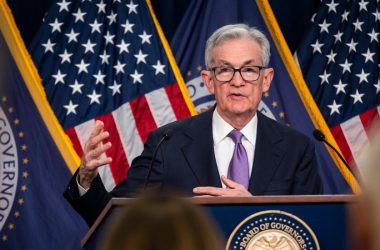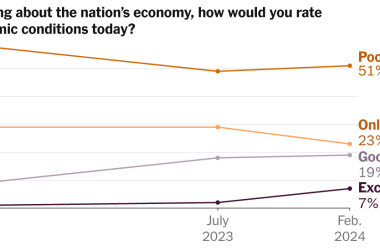Sleek Artwork Deco buildings towering above Chicago’s key enterprise district report occupancy charges as little as 17 %.
A set of gleaming workplace towers in Denver that had been stuffed with tenants and price $176 million in 2013 now sit largely empty and had been final appraised at simply $82 million, in accordance with knowledge supplied by Trepp, a analysis agency that tracks actual property loans. Even famous Los Angeles buildings are fetching roughly half their prepandemic prices.
From San Francisco to Washington, D.C., the story is similar. Workplace buildings stay caught in a slow-burning disaster. Workers despatched to make money working from home at the beginning of the pandemic haven’t totally returned, a scenario that, mixed with excessive rates of interest, is wiping out worth in a significant class of economic actual property. Costs on even higher-quality workplace properties have tumbled 35 % from their early-2022 peak, primarily based on knowledge from Inexperienced Avenue, an actual property analytics agency.
These forces have put the banks that maintain a giant chunk of America’s industrial actual property debt within the scorching seat — and analysts and even regulators have stated the reckoning has but to completely take maintain. The query will not be whether or not large losses are coming. It’s whether or not they may show to be a sluggish bleed or a panic-inducing wave.
The previous week introduced a style of the brewing issues when New York Group Financial institution’s inventory plunged after the lender disclosed sudden losses on actual property loans tied to each workplace and house buildings.
To date “the headlines have moved quicker than the precise stress,” stated Lonnie Hendry, chief product officer at Trepp. “Banks are sitting on a bunch of unrealized losses. If that sluggish leak will get uncovered, it may get launched in a short time.”
Final 12 months’s worries are as we speak’s issues.
When a string of banks failed final spring — partly due to rising rates of interest that had decreased the worth of their property — analysts fretted that industrial actual property may set off a wider set of issues.
Banks maintain about $1.4 trillion of the $2.6 trillion in industrial actual property loans set to mature over the subsequent 5 years, primarily based on knowledge from Trepp, and small and regional lenders are especially active available in the market.
Economists and regulators feared that heavy publicity to the dicey-looking business may spook financial institution depositors, notably these with financial savings above the $250,000 restrict for presidency insurance coverage, and immediate them to withdraw their funds.
However authorities officers responded forcefully to the 2023 upheaval. They helped dump failing establishments, and the Federal Reserve arrange an affordable financial institution funding choice. The actions restored confidence, and financial institution jitters pale from view.
That has modified in current days with the problems at New York Group Financial institution. Some analysts are dismissing it as a one-off. New York Group Financial institution absorbed the failing Signature Financial institution final spring, accelerating its troubles. And up to now, depositors should not pulling their cash out of banks in giant numbers.
However others see the financial institution’s plight as a reminder that many lenders are in for ache, even when it doesn’t spur systemwide panic. The reprieve the federal government supplied the banking system final 12 months was non permanent: The Fed’s funding program is set to shut down subsequent month, as an example. Industrial actual property issues are lasting.
The ache has but to be realized.
Industrial actual property is a large asset class that features retail, multifamily housing and factories. The sector as an entire has had a tumultuous few years, with workplace buildings hit particularly laborious.
About 14 % of all industrial actual property loans and 44 % of workplace loans are underwater — which signifies that the properties are price lower than the debt behind them — in accordance with a recent National Bureau of Economic Research paper by Erica Xuewei Jiang from the College of Southern California, Tomasz Piskorski from Columbia Enterprise Faculty and two of their colleagues.
Whereas big lenders like JPMorgan Chase and Financial institution of America have begun setting apart cash to cowl anticipated losses, analysts stated, many small and medium banks are downplaying the potential value.
Some places of work are nonetheless formally occupied even with few staff in them — what Mr. Hendry known as “zombies” — because of yearslong lease phrases. That permits them to look viable when they don’t seem to be.
In different circumstances, banks are utilizing short-term extensions fairly than taking on struggling buildings or renewing now-unworkable leases — hoping that rates of interest will come down, which might assist elevate property values, and that staff will return.
“If they’ll prolong that mortgage and preserve it performing, they’ll postpone the day of reckoning,” stated Harold Bordwin, a principal at Eager-Summit Capital Companions, a distressed actual property brokerage.
Financial institution-reported delinquency charges have remained much lower, at simply above 1 %, than these on commercial real estate loans that trade in markets, that are over 6 %. That’s an indication that lenders have been sluggish to acknowledge the constructing stress, stated Mr. Piskorski, the Columbia economist.
A whole lot of banks are in danger.
However hopes for an workplace actual property turnaround are trying much less lifelike.
Return-to-office traits have stalled out. And whereas the Fed has signaled that it doesn’t anticipate to lift rates of interest above their present stage of 5.25 to five.5 %, officers have been clear that they’re in no hurry to chop them.
Mr. Hendry expects that delinquencies may almost double from their present fee to the touch between 10 and 12 % by the tip of this 12 months. And because the reckoning grinds on, a whole bunch of small and medium banks could possibly be in danger.
The worth of financial institution property has taken a beating amid larger Fed charges, Mr. Piskorski and Ms. Jiang discovered of their paper, which signifies that mounting industrial actual property losses may go away many establishments in unhealthy form.
If that had been to rattle uninsured depositors and immediate the form of financial institution runs that toppled banks final March, many may plunge into outright failure.
“It’s a confidence sport, and industrial actual property could possibly be the set off,” Mr. Piskorski stated.
Their paper estimates that dozens to greater than 300 banks may face such catastrophe. That may not be a crushing blow in a nation with 4,800 banks — particularly as a result of small and medium lenders should not as linked to the remainder of the monetary system as their bigger counterparts. However a speedy collapse would danger a broader panic.
“There’s a situation the place it spills over,” Mr. Piskorski stated. “The extra seemingly situation is a sluggish bleed.”
Regulators are attuned to the menace.
Officers on the Fed and the Treasury Division have made it clear that they’re carefully monitoring each the banking sector and the industrial actual property market.
“Industrial actual property is an space that we’ve lengthy been conscious may create monetary stability dangers or losses within the banking system, and that is one thing that requires cautious supervisory consideration,” Treasury Secretary Janet L. Yellen stated throughout congressional testimony this week.
Jerome H. Powell, the Fed chair, acknowledged throughout a “60 Minutes” interview that aired on Sunday that “there can be losses.” For giant banks, Mr. Powell stated, the chance is manageable. With regards to regional banks, he stated that the Fed was working with them to cope with anticipated fallout, and that some would wish to shut or merge.
“It appears like an issue we’ll be engaged on for years,” Mr. Powell admitted. He known as the issue “sizable” however stated that “it doesn’t seem to have the makings of the sort of disaster issues that we’ve seen generally previously, for instance, with the worldwide monetary disaster.”
Alan Rappeport contributed reporting.










